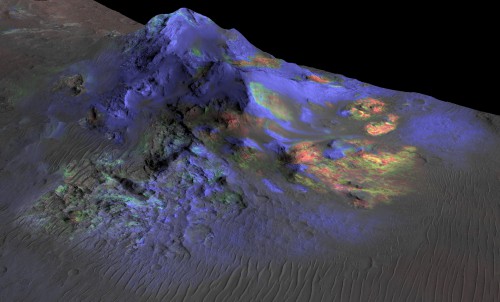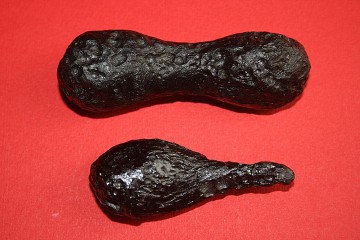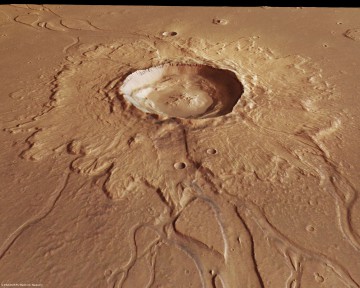
For the first time, impact glass has been detected on the surface of Mars; the discovery not only provides new information about the formation of impact craters, but might even offer clues to the possibility of ancient life on the Red Planet. The discovery was made by the Mars Reconnaissance Orbiter (MRO) spacecraft.
Impact glass is also found on Earth, formed by the heat of violent meteorite impacts a long time ago. Geologically, that is interesting enough on its own, but impact glass is also known for preserving biosignatures of past life, including organic molecules and even plant matter. Such a discovery was reported by scientist Peter Schultz of Brown University in 2014, regarding an impact which occurred in Argentina millions of years ago.

The new study was just published online by Brown University researchers Kevin Cannon and Jack Mustard in the journal Geology.
“The work done by Pete and others showed us that glasses are potentially important for preserving biosignatures,” Cannon said. “Knowing that, we wanted to go look for them on Mars and that’s what we did here. Before this paper, no one had been able to definitively detect them on the surface.”
Impact glass deposits are not easy to detect remotely, since they tend to have weak spectral signatures. Scientists identify minerals and rocks remotely by measuring the spectra of light coming off them.
As Mustard noted: “Glasses tend to be spectrally bland or weakly expressive, so signature from the glass tends to be overwhelmed by the chunks of rock mixed in with it. But Kevin found a way to tease that signal out.”
To help with their research, Cannon mixed together powders which have a similar composition to Mars rocks, and then fired them in an oven to produce glass, simulating the heat of an impact. He then measured the spectral signal from the newly formed glass. Finally, he used an algorithm to pick out similar signals in the data from MRO’s Compact Reconnaissance Imaging Spectrometer for Mars (CRISM). Several deposits have been found so far, in the central peaks of impact craters. Being located on central peaks suggests they are related to the impact formation of the crater. One of the craters, called Hargraves, is near the Nili Fossae trough, a 400-mile-long (650-kilometer-long) depression which is one of the landing site contenders for NASA’s Mars 2020 rover, a mission that will cache soil and rock samples for possible return to Earth by another subsequent mission.

Nili Fossae is already of great interest to planetary scientists, since it is thought that the crust in this region dates back to when Mars was once a much wetter place than it is now. There are also features which are thought to be ancient hydrothermal fractures in the region.
“If you had an impact that dug in and sampled that subsurface environment, it’s possible that some of it might be preserved in a glassy component,” Mustard said. “That makes this a pretty compelling place to go look around, and possibly return a sample.”
If life ever existed on Mars, even just microbial, it could potentially be preserved in a similar way in Martian impact glass, making this a new way to search for such evidence. The search for possible chemical and organic biosignatures will also be the focus of upcoming missions, such as the Mars 2020 rover and ExoMars.
“The researchers’ analysis suggests glass deposits are relatively common impact features on Mars,” said Jim Green, director of NASA’s planetary science division at the agency’s headquarters in Washington. “These areas could be targets for future exploration as our robotic scientific explorers pave the way on the journey to Mars with humans in the 2030s.”
The finding is also a testament to how much information MRO has sent back, and continues to send back, about Mars; it has been continuously orbiting the planet since 2006, helping to revolutionize our understanding of this fascinating world, along with other orbiters, rovers, and landers.
“This significant new detection of impact glass illustrates how we can continue to learn from the ongoing observations by this long-lived mission,” said Richard Zurek, MRO project scientist at NASA’s Jet Propulsion Laboratory (JPL) in Pasadena, Calif.
More information about CRISM is available here and Mars Reconnaissance Orbiter here.
Want to keep up-to-date with all things space? Be sure to “Like” AmericaSpace on Facebook and follow us on Twitter: @AmericaSpace




2 Comments
2 Pings & Trackbacks
Pingback:[SPACE] Mars news by ICFire - TribalWar Forums
Pingback:Impact glass discovered on Mars: how it might help in search for evidence of past life